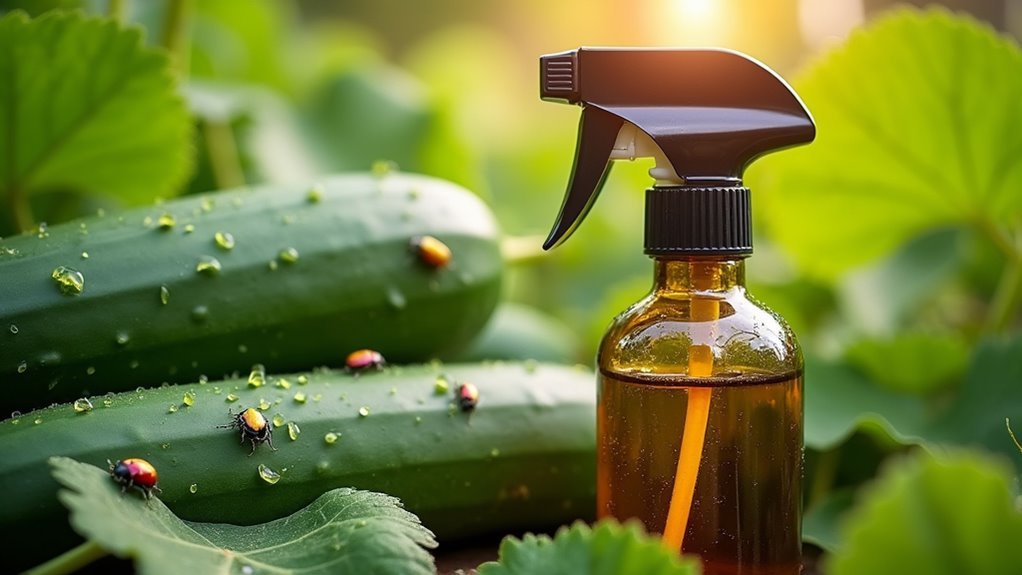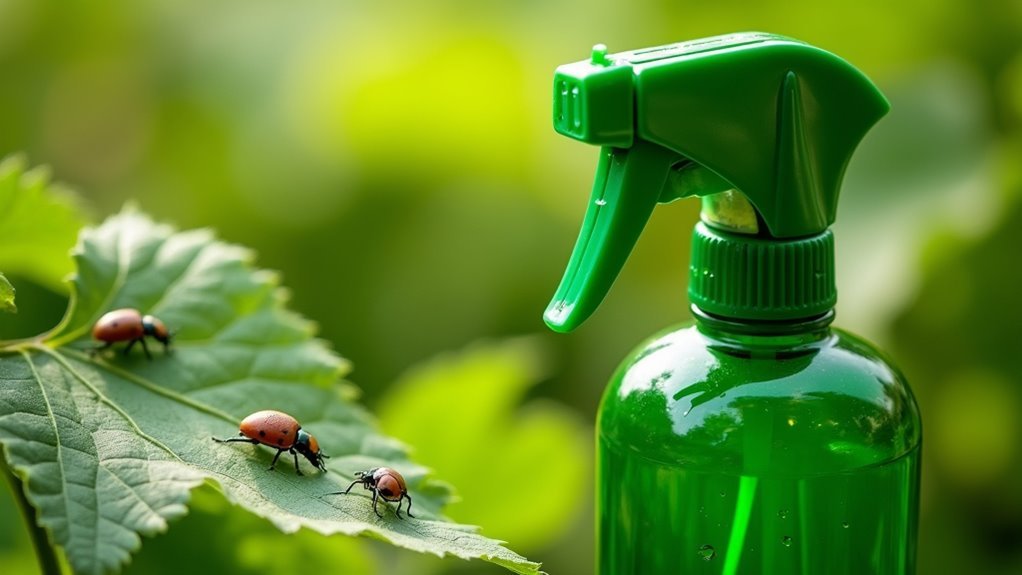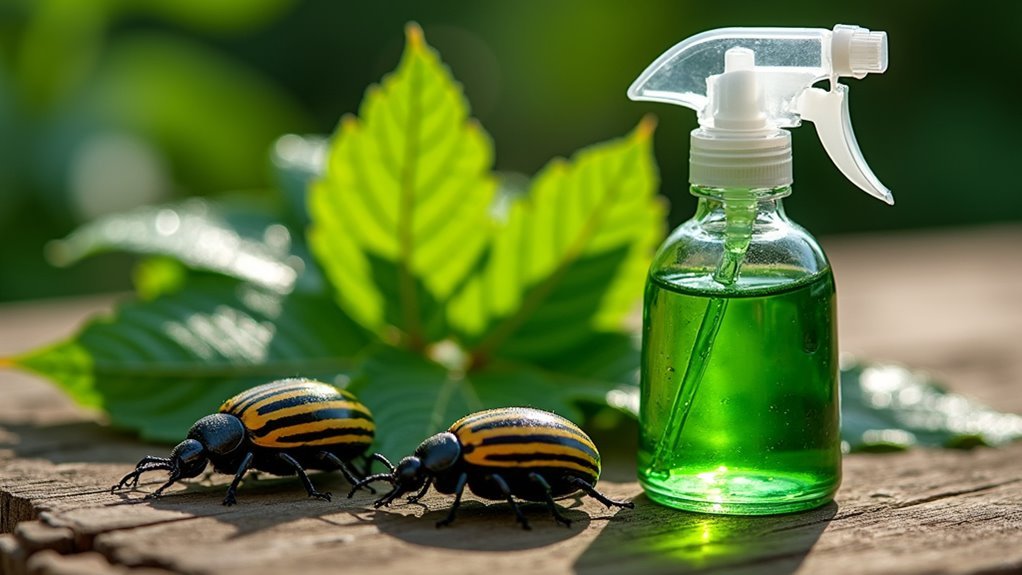You’ll need just three ingredients to create an effective neem oil spray against cucumber beetles: one teaspoon pure neem oil, one quart water, and 1/4 teaspoon non-antibacterial dish soap as an emulsifier. Mix thoroughly and apply during early morning or late afternoon every 7-14 days. The neem oil’s azadirachtin disrupts the beetles’ feeding and reproductive cycles while repelling them with its bitter odor. This organic solution protects your cucumbers, squash, and pumpkins while there’s much more to discover about maximizing effectiveness.
Understanding Cucumber Beetles and Their Garden Damage

While these tiny pests may seem insignificant at first glance, cucumber beetles pack a devastating punch that can destroy your entire cucurbit crop.
These 1/4-inch striped and spotted beetles target your cucumbers, squash, and pumpkins with ruthless efficiency. They’ll lay eggs at your plant bases, and when larvae emerge after 40-60 days, they’ll attack the roots while adults feast on leaves and developing fruit.
You’ll notice wilting or yellowing leaves, unsightly holes, and cosmetic damage to your harvest.
Even worse, cucumber beetles transmit bacterial wilt, causing plants to droop during the day and recover at night.
For organic gardening success, you must act quickly—even without visible symptoms—because these populations explode rapidly and devastate vulnerable plants.
Why Neem Oil Works Against Cucumber Beetles
When cucumber beetles invade your garden, neem oil becomes your most powerful organic defense weapon. This natural solution works through multiple mechanisms to control cucumber beetles effectively.
Neem oil’s active ingredient, azadirachtin, disrupts the beetles’ feeding and reproductive cycles, gradually reducing their population. The compound interferes with their hormonal systems, preventing successful reproduction and development.
Azadirachtin targets cucumber beetles at their biological core, disrupting hormonal systems to halt reproduction and gradually eliminate infestations naturally.
Here’s how neem oil attacks cucumber beetles:
- Repels through smell and taste – The bitter, garlicky odor makes your plants unappealing to beetles.
- Disrupts feeding patterns – Beetles avoid treated plants, protecting your crops from damage.
- Breaks reproductive cycle – Azadirachtin prevents successful egg laying and larval development.
Applied every 7-14 days, you’ll see significant beetle reduction while keeping beneficial insects safe.
Essential Ingredients for Neem Oil Cucumber Beetle Spray

Creating an effective neem oil spray requires just a few simple ingredients that you likely already have at home.
You’ll need pure neem oil as your primary weapon against cucumber beetles. For every quart of water, mix in one teaspoon of neem oil to achieve the proper concentration for effective pest control.
Don’t forget the vital third ingredient: non-antibacterial dish soap. Add 1/4 teaspoon per quart to act as an emulsifier, helping the oil blend properly with water and stick better to plant surfaces.
This simple addition guarantees your spray won’t separate and provides maximum coverage where cucumber beetles feed.
These three basic ingredients create a powerful, natural defense system that targets cucumber beetles while remaining safe for your plants and garden ecosystem.
Step-by-Step Mixing Instructions for Maximum Effectiveness
Now that you have your ingredients ready, proper mixing technique makes all the difference in creating a potent cucumber beetle deterrent. Follow these precise steps to guarantee your neem oil spray delivers maximum pest control effectiveness.
Proper mixing technique transforms your neem oil ingredients into a powerful cucumber beetle deterrent that delivers maximum pest control results.
- Combine the base ingredients: Mix 1 teaspoon of neem oil with 1 quart of water in your spray container, then add 1/4 teaspoon of non-antibacterial dish soap as an emulsifier.
- Shake vigorously: Thoroughly agitate the mixture to guarantee all components blend completely, creating a uniform solution that’ll stick to plant surfaces.
- Time your application: Apply during early morning or late afternoon to prevent plant damage and target cucumber beetles when they’re most active and vulnerable to treatment.
Proper Application Techniques and Timing

Since timing determines the success of your neem oil treatment, you’ll need to target specific windows when cucumber beetles are most vulnerable.
Apply during early morning or late afternoon to prevent leaf burn and maximize effectiveness. These proper application techniques start with shaking your mixture well to guarantee emulsification and proper adherence to plant surfaces.
Test the spray on a small plant area first to check for adverse reactions. Once confirmed safe, apply thoroughly to all affected areas.
Reapply every 7-14 days, particularly after rainfall, to maintain protection against beetle populations.
Monitor your plants closely post-application for continued pest activity. Adjust your treatment schedule based on observed beetle presence to guarantee peak results.
How Often to Reapply Neem Oil Treatment
Three key factors determine your neem oil reapplication schedule: beetle activity levels, weather conditions, and plant growth stage.
You’ll need to reapply every 7-14 days to maintain effective protection against cucumber beetles and other garden pests.
Monitor these critical situations requiring immediate reapplication:
- After heavy rainfall or irrigation – Water washes away neem oil, leaving plants vulnerable to cucumber beetle attacks
- During active beetle seasons – Increase frequency when you spot fresh damage or adult beetles on foliage
- Following rapid plant growth – New leaves lack protection and need fresh coverage
Always mix fresh neem oil solution for maximum potency.
Target both leaf surfaces during application, and conduct regular plant inspections to assess pest pressure.
This proactive approach guarantees continuous protection throughout the growing season.
Safety Precautions When Using Neem Oil Spray
You’ll need to follow essential safety measures when applying neem oil spray to protect both yourself and your plants.
Start by wearing gloves and a mask during mixing and application, then test the solution on a small plant area first.
Time your applications carefully by avoiding peak sunlight hours to prevent leaf damage and guarantee ideal absorption.
Proper Application Timing
When you’re ready to apply neem oil spray against cucumber beetles, timing becomes essential for both effectiveness and plant safety. Proper application timing directly impacts how well the neem oil works and protects your plants from damage.
Follow these timing guidelines for best results:
- Apply during early morning or late afternoon to minimize leaf burn risk and maximize effectiveness against cucumber beetles.
- Avoid peak sunlight hours (10 AM – 4 PM) when heat can degrade the oil’s potency and harm your plants.
- Reapply every 7-14 days, especially after rain to maintain the protective barrier.
Always test your neem oil mixture on a small plant area first to check for adverse reactions.
This simple timing strategy guarantees you’ll get maximum pest control while keeping your cucumber plants healthy and thriving.
Protective Gear Requirements
The safety of your application process depends heavily on wearing appropriate protective gear before handling neem oil spray.
Start with nitrile or rubber gloves to prevent skin irritation from the oil’s active compounds. Protect your eyes with safety goggles that shield against splashes and mist during application.
You’ll need a mask or respirator when working in enclosed spaces or applying large quantities to avoid inhaling neem oil particles. Cover exposed skin by wearing long-sleeved shirts and long pants throughout the entire process.
Always read the manufacturer’s safety guidelines on your neem oil product label before starting.
This protective gear guarantees you can safely apply your cucumber beetle spray while minimizing health risks and maintaining effective pest control results.
Plant Testing Guidelines
Before applying neem oil spray across your entire cucumber crop, conduct a patch test on a small section of leaves to identify potential adverse reactions. These plant testing guidelines guarantee you’ll protect your plants from unnecessary damage while effectively targeting cucumber beetles.
Mix a diluted solution using 1 teaspoon neem oil per quart of water to minimize phytotoxicity risks. Apply this test spray during cooler morning or late afternoon hours when temperatures won’t cause leaf burn.
Follow these essential steps:
- Wait 24 hours after the patch test to observe any signs of plant distress
- Avoid treating drought-stressed or environmentally compromised plants
- Monitor test areas carefully for yellowing, wilting, or spotting before full application
This careful approach prevents widespread plant damage while maintaining effective pest control.
Combining Neem Oil With Other Natural Pest Control Methods
You’ll maximize neem oil’s effectiveness against cucumber beetles by combining it with other natural pest control strategies that work synergistically.
Physical barriers like row covers can protect your plants during vulnerable growth stages while you’re establishing beneficial insect populations to work alongside neem treatments.
This integrated approach creates multiple lines of defense that cucumber beetles can’t easily overcome, giving you better long-term control than relying on neem oil alone.
Integrated Physical Barriers
While neem oil provides excellent protection against cucumber beetles on its own, combining it with physical barriers creates a formidable defense system that’s far more effective than either method alone.
You’ll maximize your garden’s protection by implementing these integrated approaches:
- Row covers with neem oil treatment – Install covers immediately after planting, then remove only when flowers appear for pollination.
- Kaolin clay application – Mix this with your neem oil spray to create a gummy coating that disrupts beetle movement and feeding.
- Sticky trap placement – Position these strategically around treated plants to catch beetles that bypass your neem oil protection.
This multi-layered strategy guarantees cucumber beetles face multiple obstacles. The physical barriers prevent initial access while neem oil’s bitter taste repels persistent insects, giving your plants thorough protection throughout the growing season.
Beneficial Insect Combinations
Creating a thriving ecosystem in your garden means strategically combining neem oil treatments with beneficial insects that naturally hunt cucumber beetles.
You’ll want to introduce ladybugs and lacewings alongside your neem applications, as these predators actively seek out and eliminate cucumber beetles while your neem oil disrupts the pests’ feeding and reproductive cycles.
Time your neem oil sprays carefully to avoid harming beneficial insects. Apply treatments in early morning or evening when helpful predators are less active.
Consider companion planting with marigolds and other flowering plants that attract these natural allies. This creates multiple defense layers against cucumber beetles.
When you establish this balanced approach, you’re building a self-sustaining pest management system that reduces your reliance on frequent chemical interventions while maintaining effective cucumber beetle control.
Expected Results and Timeline for Beetle Control
Within hours of applying neem oil spray, you’ll notice a marked reduction in cucumber beetle activity on your plants. The neem oil disrupts their feeding patterns and reproductive cycles, creating immediate and long-term benefits for your garden.
For sustained control, you’ll need to maintain a consistent treatment schedule:
- Reapply every 7-14 days to maintain effectiveness, especially after rain or heavy watering
- Monitor plants regularly for returning cucumber beetles to catch infestations early
- Combine with physical traps for thorough beetle management and better long-term results
Over time, you’ll see fewer cucumber beetles establishing themselves on your plants. The disruption to their reproduction means future generations will be smaller, gradually reducing the overall population pressure on your crops.
Storing Your Homemade Neem Oil Solution
You’ll need to store your homemade neem oil solution correctly to maintain its pest-fighting power against cucumber beetles.
Proper storage conditions and understanding shelf life guidelines will guarantee your spray remains effective when you need it most.
Let’s explore how to keep your neem oil mixture potent and ready for action.
Proper Storage Conditions
Once you’ve prepared your neem oil solution, proper storage becomes critical for maintaining its pest-fighting effectiveness against cucumber beetles.
The right proper storage conditions will preserve the active compounds that make neem oil such a powerful organic pesticide.
Store your solution in these ideal conditions:
- Cool, dark environment – Keep temperatures between 50°F and 70°F (10°C to 21°C) away from direct sunlight
- Sealed, opaque container – Use airtight containers that block light exposure to prevent ingredient breakdown
- Low humidity areas – Avoid spaces with moisture or temperature fluctuations that compromise stability
Label your container with the preparation date, as homemade solutions work best within 1-2 months.
For extended storage, refrigerate the mixture but let it reach room temperature before applying to guarantee proper emulsification.
Shelf Life Guidelines
Understanding how long your homemade neem oil solution remains effective helps you maximize its cucumber beetle control while avoiding wasted applications.
Your freshly prepared mixture delivers peak potency within the first 1-2 weeks, making this timeframe ideal for treating cucumber beetle infestations. However, you can extend the shelf life up to 30 days with proper storage techniques.
Always label your container with the preparation date so you’ll know exactly when you mixed it. This simple practice prevents you from using degraded neem oil that won’t effectively combat pests.
Remember to shake thoroughly before each application, as ingredients naturally separate over time. While your solution remains usable for up to a month, fresher batches consistently deliver superior results against cucumber beetles.
Troubleshooting Common Neem Oil Application Problems
Several issues can undermine your neem oil spray’s effectiveness against cucumber beetles, but most problems stem from basic application errors.
Most neem oil failures against cucumber beetles result from simple mistakes in mixing, timing, or application coverage rather than product ineffectiveness.
If your spray isn’t working to kill cucumber beetles, check these common mistakes:
- Improper mixing – You’re not creating a proper emulsion with water and non-antibacterial dish soap, causing poor adherence to leaves.
- Wrong timing – You’re applying during peak sunlight instead of early morning or late afternoon, leading to leaf burn and reduced absorption.
- Inadequate coverage – You’re missing the undersides of leaves where beetles hide, or using incorrect concentration (should be 1 teaspoon per quart).
Always perform patch tests on sensitive plants before full application.
Reapply every 7-14 days or after rainfall to maintain effectiveness against these persistent pests.
Frequently Asked Questions
How Do You Make Cucumber Beetle Spray?
You’ll mix 1 teaspoon neem oil with 1 quart water and 1/4 teaspoon dish soap. Shake well, test on small plant area first, then spray during early morning or late afternoon.
Will Neem Oil Kill Cucumber Beetles?
Neem oil won’t directly kill cucumber beetles, but it’ll disrupt their feeding and reproduction cycles. You’ll see reduced populations as the azadirachtin repels them with its bitter taste, making your plants less appealing.
How to Get Rid of Cucumber Beetles With Home Remedies?
You can control cucumber beetles using several home remedies: spray neem oil solution, apply diatomaceous earth around plants, handpick beetles into soapy water, use yellow traps, or install row covers.
What Is the Ratio of Neem Oil to Water for Spray?
You’ll want to mix 1 teaspoon of neem oil with 1 quart of water for basic applications. For larger batches, use 1 tablespoon per gallon of water instead.
In Summary
You’ll see cucumber beetle populations drop within days of consistent neem oil applications. Don’t expect overnight results – it takes time for the oil to disrupt their feeding and reproductive cycles. Keep applying every 7-10 days until you notice significant reduction in beetle damage. Remember, you’re creating a hostile environment that forces these pests to find new homes. With patience and regular treatments, you’ll reclaim your cucumber plants from these destructive invaders.





Leave a Reply